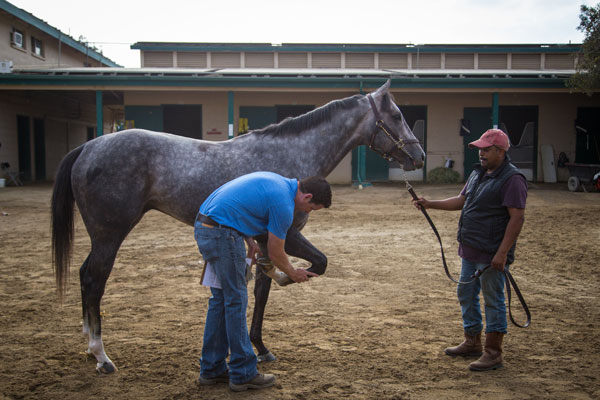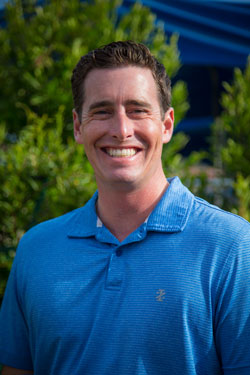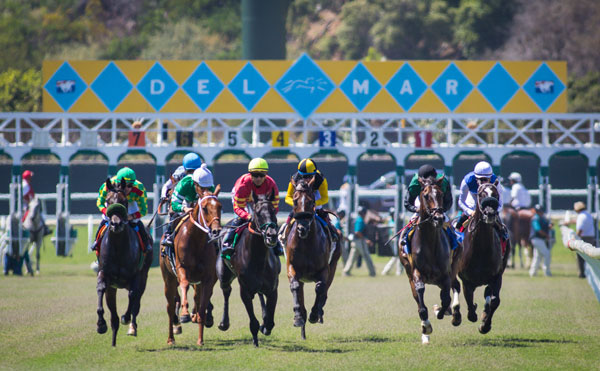
By Mac McBride
Dr. Dana Stead is bending down. He does a lot of that.
He’s bending over the right front leg of a Thoroughbred racehorse on the backstretch at Del Mar at 6:40 on a Thursday morning. After he finishes, he slides over and bends over the horse’s left front leg. He’ll do that again and again on other horses – more than 30 different times this day. Other mornings he might do it as many as 40 or 50 times.
Del Mar’s racing veterinarian, the “association veterinarian” (as opposed to the two state veterinarians who also work at the track), spends race-day mornings making sure the horses scheduled to run that afternoon are fit and ready to do so. When he does his bending, he picks up the various horses’ legs and feels them from the knee to the ankle (fetlock), doing what medical folks call palpating, or the laying on of hands to determine the health of the body part(s) being touched. He flexes each leg backwards, bending them firmly.
“I’m looking for things that are not good signs for the horse,” the 35-year-old Stead says. “Heat in the legs is a warning, swelling is another, exceptional tenderness to the touch also. I feel the tendons and the ligaments; are they tight, or loose and mushy? I keep cards on every horse on the circuit, going well back into their history. I might know that a certain horse has had an issue with the tendon in his right front. I’ll be sure to check that closely. Some of these horses I know almost by heart. The good ones are easy to deal with. The ones with problems tend to stand out, too, in another way.”
Besides the palpating, Stead also has a groom or an assistant trainer jog a horse 50 feet or so away from him, then 50 feet back. It is telling to him how the horse moves through the simple exercise.
“The jog with a horse is perfectly balanced,” the vet says. “All four legs rolling forward easily in unison, evenly spaced and hitting the ground in a steady, uniform tempo. When a horse walks or runs, they tend to favor one leg or the other. They change their leads. But the jog is the only even gate.”
Stead’s exams, which go on from three to four hours each morning, are not meant to prove perfection. They are meant to show that a horse is “racing sound.”
“Virtually none of these horses is 100% perfect physically,” he notes. “They all are eligible to have their little aches and pains. No athlete is physically perfect. Look at our Olympic athletes now. You see a lot of them covered in kinesiology tape. When you race and you train, issues arise. Athletes work though those issues; it’s the nature of competing.
“But little aches and pains shouldn’t cause big problems; shouldn’t cause breakdown problems with horses. The big problems are the ones I’m looking for – the ones that I need to spot ahead before they express themselves on the track.”
 Stead estimates he walks from six to eight miles each race morning through the Del Mar barn area, searching out the horses he needs to inspect from that day’s race card. (Another veterinarian, sometimes even a third, also will be performing inspections of the remaining runners among the entries.) The Glendale native must track down both horse and a handler at the various barns, not always the easiest of things to do. But he has a nice edge among the primarily Hispanic community that populates the backstretch in that he speaks a ready Spanish (“I’m about 80% fluent.”), which limits confusion and expedites the examinations.
Stead estimates he walks from six to eight miles each race morning through the Del Mar barn area, searching out the horses he needs to inspect from that day’s race card. (Another veterinarian, sometimes even a third, also will be performing inspections of the remaining runners among the entries.) The Glendale native must track down both horse and a handler at the various barns, not always the easiest of things to do. But he has a nice edge among the primarily Hispanic community that populates the backstretch in that he speaks a ready Spanish (“I’m about 80% fluent.”), which limits confusion and expedites the examinations.“When I first started doing this job in 2009, I got tested pretty good,” he recalls with a smile. “Some of these old trainers had no problem telling me that they’d trained horses since before I was born and that they didn’t want any problems from me. Then I’d see something I didn’t like and scratch one of their horses and I’d really hear about it. But they learned me and I learned them and it’s all working out fine. Maybe I’d scratch one horse a day at the beginning. People were wanting to see if they could get problems past me. I think they learned they couldn’t, so they stopped trying. Now I might scratch one horse a week.”
If Stead or the other vets do scratch a horse, they go on the track’s “Vet’s List,” which is a form of racing jail that doesn’t allow for those horses to compete. The minimum “sentence” for “Vet’s List” horses is 10 days, but it can go on for more than that. The key to getting off the list is to work five furlongs (in at least 1:03) in front of a veterinarian and to pass physical inspections by that vet both before and after the exercise.
This morning Stead had to deal with two horses whose trainers said they were ready to come off the “Vet’s List.” One had been on the list for only 10 days for a minor issue, while the other had been out of action for six weeks. Both withstood physical checks beforehand, then each worked their five furlongs in under the allotted time. Finally, they both cooled out properly and showed well in their follow-up checks an hour later. Stead released them both for racing.
Stead learned his love for the horse growing up and riding “cutting” horses (mostly Quarter horses), as well as getting close to them through his grandfather, who was a Thoroughbred owner in California from the ‘60s to the ‘80s. With that in mind, he wound up at Colorado State University in Fort Collins and earned an undergraduate degree in Animal Science. He then applied to the school’s highly respected veterinarian school and made it in – one of only 133 students accepted from over 1,400 applicants. Four years later he was a veterinarian with an emphasis on large animals. There was a one-year internship with those “cutting” horses in Texas that followed (“Toughest year of my life; worked 100 hours a week.”) before he returned to Southern California and caught on at the racetrack.
Dr. Rick Arthur, the Equine Medical Director for the California Horse Racing Board and the man who oversees all things veterinarian in the state, remembers hiring Stead in 2009.
“He was serious, professional and motivated,” Arthur recollected. “He also showed me he was a sharp veterinarian. I was looking for someone who wanted to make a career of track vet work and who would be open to new ideas. Dr. Stead fit that bill.”
Seven years later, Arthur believes he made the right call in hiring him to work the circuit -- Del Mar, Santa Anita and Los Alamitos.
“Dr. Stead provides consistency and professionalism to the Southern California Thoroughbred circuit,” he noted. “The track veterinarian is a vital component to horse and jockey safety and our first responder for on-track emergencies. Dr. Stead handles a tough job extremely well.”
Besides his morning inspections, Stead is also involved in three additional afternoon inspections of all runners on a race-day card. He – and the track’s other vets – will see and inspect the horses in the receiving barn before they head to the paddock to be saddled. Stead is there again in the walking ring to eyeball the runners as they go through their final preparations, then he follows them down to the racetrack and observes their warm-ups prior to heading to the starting gate.

When the horses do break from the gate, it is Stead and one of the gatemen in a vehicle on the outer portion of the main track racing behind them should an accident or injury occur during the race. They are ready to go directly to aid any of the horses, while an ambulance and its drivers race along with them with ready services for any of the riders.
Stead, fit and trim, says he uses his off days to hit the gym and work with a human trainer, emphasizing – perhaps not surprisingly -- the muscles around his lower back. (“I work with a chiropractor, too.”) He’s what some would call a workaholic, rarely taking days off. (“I might take a week each year, but that’s about it.”) But he says – on most days – he loves his work and feels lucky to be doing it.
“Even when we lose a horse – and I might be the one that has to euthanize them – I find a blessing in that to go with the curse,” he says. “I took an oath to relieve suffering. And though it can be tough, I find a positive in the negative knowing I’m relieving suffering. I don’t want to have to euthanize any animals – I don’t hunt and I’m not in favor of it – but sometimes circumstances give you no other choice.
“I remember that my job is to protect our horses and jockeys when I go to work each day. That’s what I try to do as best as I can. That’s what I’m here for.”
All photos are © Zoe Metz for Del Mar Thoroughbred Club
